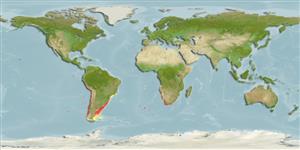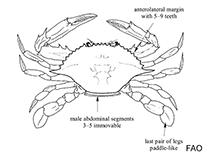Ovalipes trimaculatus (De Haan, 1833)
Rowing crab| Native range | All suitable habitat | Point map | Year 2050 |

|
| This map was computer-generated and has not yet been reviewed. |
| Ovalipes trimaculatus AquaMaps Data sources: GBIF OBIS |
Google image | No image available for this species;
drawing shows typical species in Portunidae.
Classification / Names Common names | Synonyms | CoL | ITIS | WoRMS
Malacostraca | Decapoda | Portunidae
Environment: milieu / climate zone / depth range / distribution range Ecology
Benthic; depth range 3 - 100 m (Ref. 106007). Subtropical; 10°S - 58°S, 110°W - 78°E
Distribution Countries | FAO areas | Ecosystems | Occurrences | Introductions
Indo-West Pacific and Southern Atlantic: from Independence Bay, Peru, to Chile and Juan Fernandez; on the Atlantic coast of South America from Sao Paulo to Argentina, Tristan da Cunha and South Africa.
Length at first maturity / Size / Weight / Age
Maturity: Lm ? range ? - ? cm
Life cycle and mating behavior Maturity | Reproduction | Spawning | Eggs | Fecundity | Larvae
Main reference
References | Coordinator | Collaborators
Servicio Nacional de Pesca y Acuicultura. 2011 Nomina de Especies. http://www.sernapesca.cl/index.php?option=com_remository&Itemid=47&func=startdown&id=5055 [Accessed 28 May 2012]. (Ref. 90098)
IUCN Red List Status
(Ref. 130435: Version 2025-1)
CITES status (Ref. 108899)
CMS (Ref. 116361)
Threat to humans
Human uses
Fisheries: commercial
| FishSource |
Tools
More information
Max. ages / sizes
Length-weight rel.
Length-length rel.
Length-frequencies
Mass conversion
Abundance
Internet sources
BHL | BOLD Systems | CISTI | DiscoverLife | FAO(Publication : search) | Fishipedia | GenBank (genome, nucleotide) | GloBI | Gomexsi | Google Books | Google Scholar | Google | PubMed | Tree of Life | Wikipedia (Go, Search) | Zoological Record



